#( hence the 9 days of navratri )
Text
HAPPY NAVRATRI !!
#∦∦ ━━ •• 𝐃𝐀𝐓𝐀 𝐃𝐄𝐂𝐑𝐘𝐏𝐓𝐈𝐎𝐍 ( ooc. )#( it's going to be a hell of a lot of fun for the next 9 days )#( my favorite festival besides diwali )#( TIME TO GARBAAAA )#( for those that like fun facts )#( nivratri and the garba that we do represents the 9 months of pregnancy )#( hence the 9 days of navratri )#( the circle is the womb and the center is ma durga )#( one of the shak tis )#( one of the main vedas in hinduism !! )#( a time to celebrate life and women! )#( garba originates from the state of gujurat where the original sanskrit developed its representation )#( cool stuff I love to share and teach every year <3 )
8 notes
·
View notes
Text
Day Six of Navratri
9 days, 9 Godesses

Day Six: Maa Katyayani
Once there lived a sage called Katyayana who prayed to the goddess to be born as his child in order to kill Mahishasura. She agreed and was born as his daughter and thus was called Katyayani. When the gods invoked Mahashakti – the primordial feminine power to protect them from the demon, Mahisha, she emerged from the sacrificial fire of the sage Katyayan. All the male gods bestowed their special powers and weapons on her. She is the avatara of Parvati in the form of the warrior goddess and is one of the most well-known and beloved of her forms.
Riding a lion, she proceeded towards the Vindhya mountains where the demon lived and killed him. Hence, she is also known as Mahishasuramardini.
Jai Maa Durga 🕉️🔱
20 notes
·
View notes
Text
https://healthzo.in/2023/11/15/9-foods-to-avoid-while-fasting/
9 Foods to Avoid While Fasting
When fasting, it is very natural to binge eat on sugary and fried food items after you have been starving all day long. The tongue craves for spicy, salty, and sugary foods after an entire day of fasting but this kind of food might not really work well with a fasting stomach and end up leaving one feeling bloated, acidic and drowsy.
Eating healthy fasting foods which are easily digestible after a whole day of fasting are therefore suggested to ensure that the stomach does not have to work very hard on spicy or fatty foods. We have even curated a 9 day Navratri diet plan for you to help you stay healthy while eating healthy fasting foods only.
Here is a list of foods to avoid while fasting. Hope it helps those fasting this festive season and during Navratris:
White Rice
This is one of the unhealthiest fasting foods. White rice is full of starch. Eating white rice after you break your fast will make you drowsy and lethargic. The body just stores it as fat and this lead to weight gain and flatulence.safe_image-2
Fried Foods
You will feel acidic and sick if you eat too much of fried food after a fast. The body needs only a minimum quantity of food to survive even during fasting. We tend to binge eating while fasting which makes the body store the excess food as fat.safe_image-3
Caffeine
Too much of caffeine in beverages like tea and coffee make you acidic and sick. These are best consumed with some food. Hence, it’s good to avoid them while fasting.safe_image-4
Carbonated Beverages
The high sugar content in these drinks makes you lethargic after consuming them while fasting. The body which was waiting for food for a couple of hours suddenly gets too much of sugar to work on which makes you feel lazy and drowsy.safe_image-5
Refined sugar or food containing too much of sugar
We tend to eat fried and sugary foods while fasting as part of our traditions. However, eating them in larger quantities contributes to weight gain even while fasting. Eat a very small portion of these items even if you must as a part of your tradition.safe_image-6
White Flour
Avoid processed food items like white flour. They are devoid of essential fiber necessary for your bowel movements. They are also devoid of nutrients and are only full of empty calories which will make you feel full but lack in essential nutrition.safe_image-7
Foods containing additives and preservatives
Again, packed food items contain a lot of artificial ingredients and preservatives which are bad for the body. They provide satisfaction only for some time and will make you feel hungry quickly again.safe_image-8
Foods containing a lot of salt
This kind of food is very bad for your blood pressure. They cause an instant hike in the blood pressure making you feel sick.safe_image-2
Dairy products
These items are tougher to digest by the body. The stomach which has been resting for some time needs easy to digest food items.safe_image-9
Healthy fasting foods are easily digestible and do not make us feel unwell. One needs to drink sufficient fluids to keep the body hydrated while fasting. It always works to make a mental note of foods to avoid while fasting so that unnecessary weight gain and bloating can be avoided too.
While, we at 98Fit have curated a 9 day Navratri healthy Diet Plan for you for more customized plan based upon your healthy needs and requirements. It’s also available in hindi here.
READ MORE....Best Indian Diet Plan Weight Loss Weight gain
#eat during a fast When fasting#Foods containing a lot of salt#Avoid processed food items like white flour
0 notes
Photo
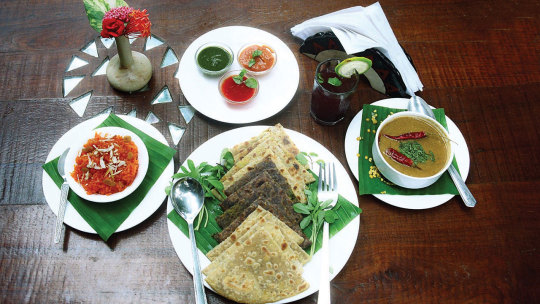
We always keep ourselves on toes to meet our daily needs. We stay busy to meet the deadlines. But to fulfil our scheduled work, we forgot to take care of our body. Our body needs to relax at least once in every six months. However, thanks to our festivals which brings in up such enthusiasm to do so.
Navratri is one such festival in which we can enjoy as well as can take good care of our health by naturally detoxifying your body with Navratri fasting.
Detoxifying means removing the toxins from your body and cleansing it just by consuming a particular diet.
Navratri is a festival of joy, happiness. It is the festival where puja of Maa Durga is performed. This festival lies in between the change of seasons and hence, to get used to such climate change, we are fasting for 9 days in which we only consume fruit & liquid diet.
Here's are some of my healthy diet tips for the Navratri fasting that will help you in your fasting.
These nine days are actually for detoxifying your body which includes cleansing, nourishing and building up.
The first three days (day 1-3) are meant for cleansing in which one should consume soup made from Green Potato, White Pumpkin, Red Pumpkin, Bottle Gourd, Green Mung Beans, Rajgira, and Buckwheat. Consume Coconut water and fruit salad to keep your metabolism up.
The next three days (Day 4-6) are for nourishing your body. For nourishment, one should consume Buckwheat, Rajgira or Moraiyo khichadi with Ghee, fruit salad made from Apple, Banana, Fig, Apricot etc. for the meal, one should consume Roti or Pancakes made from Rajgira or Buckwheat, Sama or Moong khichadi, Dry fruits, Coconut water, vegetable soup etc.
The last three days (day 7-9) are for building the immune system & energy. In these days, one should consume smoothie made from White Pumpkin, Amalaki, Pomegranate, and Banana. Include Dates & Figs along with Rajgira or Buckwheat roti with Coconut curry, or veggie & Kheer made from Sabudana or Sama.
However, avoid heavy and fried food in the entire nine days. On the tenth day, break your fast with light food, leafy vegetable and Curd. Drink enough water that will keep one hydrated the entire nine days.
Along with the fast, think positive, be positive, and perform yoga & meditation along with chanting the Maa Durga's mantra to conquer your negativity.
0 notes
Text
Pretty Sharara Suits You Can Wear With Grace This Navratri Festival

Sharara is a perfect fusion of comfort and style. This fascinating outfit was introduced by the Mughals and from that era, women enthralled them. Sharara suit is skyrocketing its popularity, and women adorn to wear them during festive and wedding seasons. Ohh! The festive season is around the corner. How can you miss the Navratri filled with Garba and pomp? Are you looking for lightweight, comfortable, and colorful ethnic garb? We have got you! Moreover, every woman wants to flaunt their Navratri 9 days festival with myriad color suits every day. We are here to help you sparkle bright with the light within you this Navratri season. Don’t miss the chance to colorful your day with different colors outfits in these 9 days.
DAY 1: SUNSHINE BRIGHT WITH THE ORANGE LIGHT
The Navratri festival holds a remarkable moment in Hindu mythology. Navratri is a cherished festival, and the orange color symbolizes the excitement, energetic, vibrant hues, warmth, and brightness. On this commencement day, the daughter of mountains, Goddess Shailputri worshipped by Hindus. You can celebrate this festival with the alluring Orange color Rayon Printed suit and accessorize your graceful look with oxidized earrings.
DAY 2: DIVINE YOUR BEAUTY WITH WHITE
Co-ordinated Sets intrude in legion colors, designs, and one of them is White. The beauty and dignity of white are as delicate as they are elegant. On this auspicious day, Hindus worshipped Maa Brahmacharini, who also wears a white dress and embodies grandeur. White colors resemble tranquility, refinement, purity, and calmness. So, what are you waiting for infuse your wardrobe with opulent white garbs and disseminate peace within your family, friends, and neighbors. You can opt for white or off-white Embellished Suits with a royal Rajasthani look, beautiful neck embroidery, and printed dupatta.
DAY 3: EMBRACE COURAGE WITH RED SHARARA SUIT
Red is deemed the most influential color in festivals. It signifies the epitome of love, beauty, and fearlessness. Goddess Chandraghanta is honored on this day, who rewards people with courage, grace, and bravery. Don the stunning Red Winsome suit this Navratri, and be ready to play Garba and Dandiya with dignity. Flaunt your style with Bandhej, Cotton Printed, jaw-dropping Gota Patti, Gold Printed three set Suit.
DAY 4: ACQUIRE HEALTH AND WEALTH WITH ROYAL BLUE
You don’t have eight hands still you, worship Ashtabhuja Devi aka Goddess Kushmanda. So, why would you stay away from this intriguing day? Royal Blue signifies health and prosperity, hence people pray for them. We have always gotten these blessings and want to receive them all the year. Enhance your gaze with Cotton Printed amazingly exquisite Sharara and complimenting dupatta. The Royal Blue beautiful Suit will make everyone’s heads turn. Minimal Oxidised or silver earrings will never harm your personality.
DAY 5: SPARKLE LIGHT THIS NAVRATRI WITH YELLOW SHARARA
Definitely, Festival is full of courage, enjoyment, and encouragement, but these 9 days exhausted the people. Don’t fret; we have something exciting for you! This Navratri accomplishes your day with an Ombre-ed yellow Grandiloquent Suit. The yellow color indulges in joy, enthusiasm, and cheerfulness. The mother of Kartikey, also known as Goddess Skandmata is celebrated on this festive day. Cotton, Georgette Floral Suit with decorated Neck knot, Thread, Embroidered work, printed, and unique dupatta are perfect garb for your Navratri. Complement your outfit with Golden or contrasting Earrings and beautiful juttis.
DAY 6: FRUITFUL YOUR DAY WITH GREEN
Why wear royal and pristine vibes garbs only on vacations or ceremonies? From Navratri to Diwali, the Ever-Green Co-ord sets are an ideal choice. The green color exemplifies Growth, Fertility, Mother of Nature, and New Beginnings. Begin your fabulous day with the exemplary Green Sharara Suit and worship the Goddess Katyayani. The Cotton Printed Suits with Gher, Gota work, and Neck Embroidery with Net Dupatta flaunt the beauty of the outfit. Look your elegant best with Statement Jewelry and Majestic footwear.
DAY 7: DESTROY YOUR EVIL WITH OPULENT GREY SUITS
Till now, you have got to know vibrant hues and bright colors garbs in Festivals. But there is a solemn, dull, and unusual color that can be worn on Navratri - Grey. The elegant hue Grey Sassy Set is quintessential for this day as people worship the Goddess Kalaratri, the destruction of evil. The Georgette or Rayon Sharara set with Gold Print, Pretty Embroidery, and unique styled Dupatta look gorgeous on Day 7.
DAY 8: IMPLEMENT YOUR ASPIRATION WITH PURPLE SUIT
Add some glamorous color outfits to this Navratri. Apt Purple color Royal Suit and glimpse P.H.A.T. on the 8th day of Navratri. Purple illustrates peace and brilliance. Worship the Goddess Mahagauri as she fulfills the desires of her devotees. Chanderi or Cotton Printed Embroidered Suit with Gota Patti work and astounding Dupatta will reflect your inner beauty. Go and show your style with stunning Purple outstanding sets.
DAY 9: DECK UP IN PEACOCK GREEN SUIT
The last day of Navratri is called Navmi, and people worship Goddess Siddhidatri. The day is observed by catering foods to adorable Children who are assumed to be the avatar of the Goddess. Slay your day with a Cotton Printed Flared Suit with Embroidery around the neck, neck knot, and irresistible Dupatta. Carry the stud Earrings, Matching Gold Potli for preserving time, and tempting sandals to seize everyone’s eyes.
Navratri is all about devotion and emotion consequently, you can pick any color as per your taste. Steal heart and limelight with Fashion Dwar Sharara dresses that are bound never yield to amaze! Plump for the trendiest Sharara suits that harmonize your Festive Season.
1 note
·
View note
Text
Navaratri - The 9 Days of Festivity
The Navratri celebration that happens as per the Hindu calendar is all about worshipping the appearance of Goddess Durga that lasts for 9 propitious days. Navratri is the celebration of Goddess Durga victory over the malevolent Mahishasura. Navaratri is regarded as the celebration of peace over ego and dharma over adharma. On each of these 9 days of Navratri, pooja and fasting is done by the believers. Each day is dedicated to worshipping each of the nine forms of Goddess Durga namely - Shailaputri, Brahmacharini, Chandraghanta, Kushmanda, Skandamata, Katyayani, Kalratri, Mahagauri, and Siddhidatri. People are in the festive mood for nine days and the days are made even more special by family gatherings, feisty food and doing the rituals and prayers at temples.
Navratri celebrations are here and it is important that you know the significance of Navratri. The nine days of Navratri celebrations are the days of celebrating the victory of light over darkness. Navratri 2021 dates begin on October 7, 2021 (Thursday) and end on October 15, 2021 (Friday). Every year Navratri is celebrated with more enthusiasm and get togethers. However, due to the corona outbreak, Navratri 2021 has to be celebrated in a low profile for the sake of the public well-being.
So, why do we celebrate Navratri every year? What is the significance of Navratri? Here are the fine points of the nine days of Navratri worship:
Day 1: On the first day, Shailaputhri is worshipped who is the personification of Goddess Parvathi. Shailaputhri represents the collective power of Brahma-Vishnu-Mahesh. The goddess is mounted upon a bull and is worshipped on the first day of Navratri.
Day 2: Brahmacharini is the Goddess worshipped on the second day of Navratri. The goddess is worshipped to attain grace, prosperity and Mukti. Devotees wear the royal blue color dress on this day. The goddess has aKumbha; in one hand and Rudraksha; on the other hand. ‘Rudraksha’ is one of the most admired religious elements for the Hindus.
Day 3: Chandraghanta is the goddess of beauty and bravery. The enthusiasts wear the yellow coloured dress on day 3. The Goddess has three eyes and ten hands. Of the ten arms, eight arms hold weapons and the remaining two are in the gesture of blessing the disciples.
Day 4: Kushmanda is the goddess worshiped on this day and is the one who blesses with green and vegetation, symbolically representing life. For obvious reasons, the colour worn on this day of celebration is green. The goddess is mounted on a lion with an astral-like aura around her.
Day 5: Skandamata is the mother of Kartikeya (also known as Skanda) and while the goddess was carrying Kartikeya in her wombs, she was chosen as the commander by the gods in their war against evil. Skandamata could transform any harm or evil coming near her into thunderstorms the colour of which looks like cloud grey. For this reason, the disciples wear dresses of grey shade on this day. The goddess used a lion as her vehicle and always held Skanda in her lap.
Day 6: Katyayani, the avatar of Goddess Durga is the daughter of Sagacious;. The goddess was very courageous and on this day when Goddess Kartyayani was worshipped, the devotees would wear orange shaded colour.
Day 7: Goddess Kalratri otherwise known as Kali is considered to be the most powerful and one of the most worshipped forms of Durga Maa. Regarded as the fiercest of all personifications of Goddess Durga, her colour was dark and the idol used for worship speaks a lot about her power and fierce nature. The Goddess fought for peace and justice and hence is linked with the colour white. Hence, white is the colour that devotees wear on the seventh day. The Goddess is mounted on a donkey and is the destructor of darkness.
Day 8: The incarnation of Durga as Maha Gouri is the symbol of optimism, intelligence, and hope. The colour pink is what the devotees wear on this day. Maha Gouri rides a bull and her idol is depicted so.
Day 9: Goddess Siddhidatri has a motherly appearance and is believed to be the goddess of healing and bestows her disciples with happiness and positivity. On this day, the temple-goers wear a blue shade dress.
The Navratri festival as the name suggests is the festival that spans nine days and is the true blend of the Indian culture, colours, festivity, religion, spirit, and celebration.
Have a happy and prosperous Navratri 2021 , Katyayani, Kad Sto all you wonderful people!
If you want to learn and know more about events happening all over India; Visit: https://www.indiaeve.com/
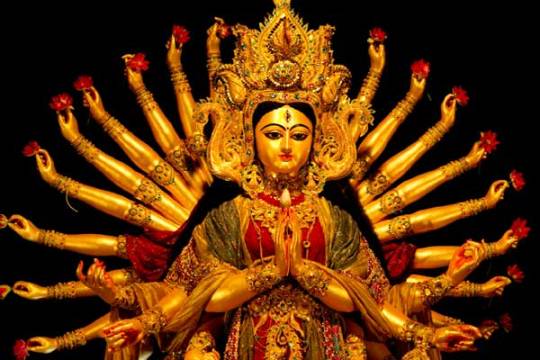
#navaratri#educational events in india#event ticketing system#events in india#upcoming events in india
1 note
·
View note
Note
Since Navratri has started can you please talk about all forms of Durga?
mmkay sure
first up : the navaratri calendar - which makes zero sense. since hinduism follows the lunar calendar, sometimes you end up with two navaratris on the same damn day, which is why the navaratri this time is 8 days instead of 9.
secondly, like i keep saying over here, you cannot consume onion, garlic, eggs and non veg until after Dussehra, which is a bummer
thirdly, in my house, we establish an akhand jyoti and a pot full of barley. the akhand jyoti, as the name suggests, has to be lit 24X7 until Dussehra is over, and has to be continuously fed and taken care of - once lit, it cannot be extinguished. the barley we sow on day one, it's saplings are used in the Dussehra pooja in my house.
so now onto the ladies :D
Prathamaa : Shailaputri - Daughter of the Mountains, this form of the goddess celebrates her as Sati Bhawani or Uma, when she was still a girl and unmarried.
Dwitiyaa : Brahmacharini - The Celibate, this form of the goddess celebrates her knowledge seeking and withdrawn form. Parvati had taken this form when she underwent severe penance to please Shiva and win his heart, and this form is also known as Aparna (she who forsook leaves, for parvati didn't consume anything during her tapas).
Tritiyaa : Chandraghanta - The Goddess with the Moonbell, this form of the goddess celebrates her royalty and bravery. A crescent moon lies on her forehead, or she wears earrings resembling the moon, thus her name. She is the first goddess who appears with ten hands, wielding weapons and riding a lion.
Chaturthi : Kushmanda - The Cosmic Egg, this form of the goddess celebrates her primordial form. It is said that Kushmanda created the entire universe just by a small smile. Yogamaya is another one of her forms.
Panchami : Skandamata - Mother of Skanda, this form of the goddess celebrates her motherly nature, and her affection towards children. She is shown as holding her infant son Skanda (also known as Kartikeya, the god of war) and wielding weapons, symbolising her protectiveness. In some depictions, she simply holds a lotus, symbolising her gentleness.
Shashti : Katyayini - Daughter of Katyayana, this form of the goddess is the most fierce. She was born of Sage Katyayana, hence the name. This is the first form the goddess took while fighting Mahishasura.
Saptami : Kaalaratri - She Who is Dark as Night, this form of the goddess is quite similar to Goddess Kali, in both character and depiction, the only difference being is that she rides a donkey while Kali rites a ghost. She is gentler than Kali, scaring away and protecting us from negative energies.
Ashtami : Mahagauri - Gauri the Great, this form celebrates Goddess Gauri as Lord Shiva's wife. She grants knowledge and wisdom to everybody. Unmarried women worship her for a suitable partner, while married women worship her to maintain marital bliss. Teej, a big festival here in North India and Rajasthan, is her own festival.
Navami : Siddhidatri - She Who Grants Power (Siddhis), Siddhidatri is the goddess' ultimate magnificent form. She bears the fruit of all the devotion and rituals during the course of these nine days, and grants the devotee whatever their heart desires.
In North India, in certain families, Navaratri ends on the seventh or eighth day only (in my family it's the eighth day). Whichever day you conclude the festival, we invite nine girls to our house and feed and worship them. The holy prasad served to the goddess that day is first given to them, untouched except for being served. Then the youngest one is given a chunari (a red, filigreed scarf which was used in the rituals), while all the girls receive gifts and money, and the hosts (ie my parents) touch all of their feet. This practice is called Kanjak. Sometimes, a boy is also invited who represents the "langur", or the monkey which guards the temples of goddesses in North India.
During this course, Ramleelas are staged parallely, which depict the entirety of Tulsidas' Ramayana, at night during stage plays and big carnivals in North India. On the tenth day, while Bengalis and South Indians submerge the goddess' idol and celebrate her victory over Mahishasura, North Indians instead celebrate Ram's victory over Ravana which is symbolised at the end of the Ramleela - the actor who plays Rama burns the giant effigies of Ravana, his brother Kumbhakarna, and his son Indrajit, by shooting flaming arrows at them.
185 notes
·
View notes
Text
DAY 9 of NAVRATRI :-

Siddhidhatri Devi is the ninth aspect of the Hindu goddess Durga and ninth Navadurga. Her name Siddhidgatri means
"Siddhi" means supernatural power or meditative ability
"Dhatri" means giver or awarder.
One side of Lord Shiva's body is of Goddess Siddhidhatri. Hence he is also known as Ardhanarishwar. It is said that Lord Shiva attained all the siddhis by worshiping her. Read more -
@bhatatuntoldstory
4 notes
·
View notes
Photo

I -Intelligence
N -Networking
D -Developing
I -Inspiration
A -Amazing…
This is what the word ‘INDIA’ symbolizes…
India- the land of energy, the ideal for all, the culture of happiness, and the power of unity! We have proved it, we mean it and we will achieve the goal to become the Superpower one day..! We dream to survive through Yoga, Science and boost our immune and protect ourselves from viruses like Corona...
Basically, India is divided among 28 states and 8 union territories starting from North to the south and spread from east to west. Get ready to explore its festivals statewide! Let’s know about the variant festivals of India in brief:
Northern India:
If we head to northern areas, festivals such as Sindhu darshan in Kashmir; melas, fairs in Rajasthan, Baisakhi, Guru Parab, Lohri festivals: in Punjab, the most famous ‘Lathmar Holi’, Ganga Pujan, Ramnavmi: in UP and many more are the major.
The joy and rejoice during the time of today festival in india are mesmerizing. If we deeply store the beautiful decorations, colorfulness, energy, and the unique style of celebrations of these festivals in our eyes, surely our life will be brightened in its hard times memorizing these festivities. As the festivals of India are major stress relievers, they make the people united and hence their smiles!
2. Eastern India:
The sun rises in the East, with a new beginning of life. The sun sets out and skies with bright colors of light. In a similar way, the people of East India grabbing on all the enthusiasm and energy, and taking inspiration from the ‘Sun’ to celebrate their traditional festivals. They set a powerful example amongst all. Losar festival in Arunachal, Bihu in Assam, Hornbill festival in Nagaland, Chhath puja in Bihar, Wangla in Meghalaya. The states of Bengal are major worshippers of goddess Durga. The Durga Puja, Basant Panchami, Holi, Diwali, Kali Puja, etc. are some majorly celebrated festivals here. Other attractions include Rath Yatra in Jagannath Puri, Buddh Purnima, etc.
3. Southern India:
South India is known as a ‘Culturally colorful state’. Pongal festival in Tamil Nadu, Onam and Thrissur Puram in Kerala, Hampi, Ugadi, and Karaga Utsav in Karnataka, Dasara, Mahamaham, etc. are some of the popular festivals in this area. The essence of culture in the south is deeply carved in each and every person living there. Along with the festivals, it is majorly rich in its intelligence and beautifully carved architectures in minds of people as well as the whole area.
4.Western India:
“When put together,
They form a melody,
When sung together,
Miracally changes the weather...
Dancing on the beats,
Expression through actions,
Depicting the story,
Create the forms of glory...”
Dance and music are prioritized as the major part of festivals in the western parts of India. When the beautifully composed melodies along with the thump of drums and other instruments, the expression dancers, the enthusiastic people, the cheering voices, the sound of crackers, the brightness of lightings, and the blossoms of flowers; all build a perfect definition of any ‘Festival’ in Western Regions.
The Rajasthani folk celebrate vibrant festivals such as Gangaur, Teej, Urs, Braj Holi, Pushkar Fair, etc. Great Gujarat includes festivals like everyone’s favorite Garba, Rann Utsav, and Kite Festival during Makar Sankranti. Maharashtra ‘the homeland of culture’ widely celebrates its festivals starting from Gudi Padwa, Holi, Ramnavmi, Diwali, Dussehra, Janmashtami, Ganesh Chaturthi, Navratri, and many more. The culture of Maharashtra reflects the culture of other states.
The traditional festivals in Goa depict the Indian as well as Portuguese culture. Many carnivals, Christmas events are the main parts of attractions amongst all the festivals.
5.Central India:
The heart of India, Madhya Pradesh celebrates the Gangaur festival, Malwa Utsav, Ujjain Kumbh Mela, Basant Panchami, Narmada Utsav, Mahashivaratri, Pachmari festival, and many musical fests as treat to citizens. The state of Madhya Pradesh offers many festivals that are only observed here in the state not anywhere else.
Along with this, Chhattisgarh has its own variety to offer among the list festivals of India such as cherchera, Koriya Mela, Fagun Wadai, Pola festival, Hareli festival, Teej festival, and much more.
As now we have traveled to the tour of festivals of India according to the regions, now let’s explore some of the commonly celebrated festivals of India in every part of it and also in many parts of the world.
a. Diwali: The festival of lights! Symbolizing the victory of brightness over darkness. Diwali is a festival full of energy and celebrated for 5-6 days mainly, Basu Baras, Dhanteras, Laxmi Pujan, Bhaidooj, Padwa, and Govardhan Pujan. In times of Diwali, you’ll observe the colorfulrangolis, beautifully decorated houses, and buildings lightened up skies with crackers, lanterns, diyas everywhere, and praying the god for the wellness of others. Diwali is one of the favorite festivals of all as it brings the families together
b. Holi: The festival of colors! Celebrated as the victory of good over evil and the festival of happiness and love. The festival symbolizes the love between Lord Krishna and Radha.
c. Navratri & Dussehra: A festival celebrating the powerful Maa Durga, i.e. the festival of strength and power. Maa Durga is worshipped for 9 days and on the tenth day, i.e. Vijaya Dashmi, Maa has known to kill The Mahishasur, and also the Ravna was killed by Ram. Hence, this festival is marked as the biggest example of victory with power.
d. Eid-Ul-Fitr: May India be a country that originated from Hinduism, but it does teach to respect every single religion associated with the people living in it. Hence, Muslims residing in India are never left blank with the celebrations. They visit the mosques and prayer. All their rituals and festivals are held in India every year and the prayers from all the people of different religions reach the creator!
e. Christmas: The celebrations for all the Christians but happiness for all. This festival mainly marks the birth of Jesus Christ celebrated across India. People symbolize by a confetti of Santa caps, wonderful decorations, delicious fests, hanging bells, and many more. People visit the church, sing the holy songs, and pray the good for themselves and others.
f. Guru Parab: Celebrating the birth anniversaries of the Sikh Gurus, this is one of the major festivals for Sikhs. All the Gurudwaras are beautifully lit up. Mainly the processions with various thrilling demonstrations, message giving acts, langars, etc. are the major parts.
So, let’s end up with few lines:
“LIVE INDIA. LIVE THE WORLD.
A BEAUTIFUL CREATION,
ALL IN ONE…!”
more visit us
All Indian Festivals
3 notes
·
View notes
Text

On the first three days, the Mother is invoked as powerful force called Durga in order to destroy all our impurities, vices and defects.
The next three days, the Mother is adored as a giver of wealth and prosperity, Lakshmi, who is considered to have the power of bestowing on her devotees the inexhaustible wealth.
The final set of three days is spent in worshiping the mother as the goddess of wisdom and spiritual knowledge, Saraswati. In order have all-round success in life, we need the blessings of all three aspects of the divine mother; hence, the worship for nine nights.
Goddess Durga is also worshipped under nine different names for the nine days in Navratri. Every day, she assumes a new character, a new look and a new duty.
First three days:
The goddess is separated as a spiritual force called Durga also known as Kali in order to destroy all our impurities.
1. The first form of Goddess Durga is called ‘Shailaputri’. She is considered the daughter of the Himalayas. She is a form of Shakti, the consort of Lord Shiva.
2. The second form of Goddess Durga is known as ‘Brahmacharini’. Her name is derivative of the word ‘Brahma’, which means ‘Tapa’ or penace. She is also a form of Uma or Parvati, a form of Mata Shakti.
3. On the third day the Goddess is worshipped as ‘Chandraghanta’. She is the symbolic representation of beauty and bravery.
Second three days:
The Mother is adored as a giver of spiritual wealth, Lakshmi, who is considered to have the power of bestowing on her devotees inexhaustible wealth, as she is the goddess of wealth
4. On the fourth day Goddess Durga is worshipped in the form ‘Kushmanda’. It is believed that Kushmanda is the creator of the entire Universe and she has created the entire Universe by her laugh.
5. On the fifth day, the form of Goddess Durga is called ‘Skandamaata’. She is actually called so because she is here represented as the mother of Skanda, the chief warrior of the Gods army.
6. On the sixth day, the Goddess Durga is worshipped as ‘Kaatyayani’. Seated on her vehicle lion, Kaatyayani has three eyes and four hands.
Final three days
The final set of three days is spent in worshipping the goddess of wisdom, Saraswati. In order to have all-round success in life, believers seek the blessings of all three aspects of the divine femininity, hence the nine nights of worship.
7. On the seventh day, the Goddess Durga is worshipped as ‘Kaalratri’. As the name suggests, Kaalratri is as black as a dark night. She has four hands, she is meant to make the devotees fearless.
8. On the eight day, the Goddess Durga is worshipped as ‘Mahagauri’. She is considered to extremely beautiful, white like snow and accessorized with white colored ornaments. She represents calmness and exhibits wisdom.
9. On the ninth day, Goddess Durga is worshipped as ‘Siddhidaatri’. It is believed she consists of all the eight siddhis. She lives on lotus and is worshipped by all.
52 notes
·
View notes
Text

The word ‘Navratri ‘means ‘Nine Nights’ when translated literally. Navratri is one of the most important festivals celebrated by Hindus in India and across the globe . The festival is celebrated with full pomp and show that reverberates happiness. In this festival, people worship the nine different forms of the Goddess Durga who symbolizes sincerity, power, and divinity. It is the longest and the most anticipated Hindu festival of the year, crossing over nine nights and ten days.
In a whole year, Navratri comes four times-one each in the months of Chaitra, Aashadh, Ashwin, and Magha. The Navratri that comes in Chaitra or Basant months in March or April is celebrated with great vigor, however, Sharad Navratri earns the most importance.
During Navratri, the ninth day is celebrated as Ram Navami. (The birth of Shri Ram).
Goddess Shakti exists in numerous ferocious as well as Serene manifestations; hence the celebration of each day of Navratri is dedicated to each Goddess embodiment for nine sacred days. Navratri is revered to show utter devotion and respect to Goddess and thus recognized with full devotion, zeal and enthusiasm all over the country. The nine incarnations of Goddess Shakti are:
Maa Shailputri,
Maa Brahmacharini,
Maa Chandrakanta,
Maa Kushmanda,
Maa Skandmata,
Maa Katyayani,
Maa Kaalratri,
Maa Mahagauri, and
Maa Siddhidatri
Being one of the celebrated and distinguished religious occurrences for Hindu community, this festival has become the most reverenced holy occasion.Like every other Indian festival, the core message of this festival remains the same – the victory of good over evil. It is believed that Goddess Durga battled with demon Mahishasura and defeated him. It signifies the faith and belief of people in the power of the goddess and that of the divinity. To celebrate her victory and Mahishasura’s defeat, the 9 days are earmarked to worship and honor the Goddess.
Each day of Navaratri , to know the the special puja dedicated to each form of Mother Goddess ,follow us on our other page (CLICK HERE ) ~ https://www.facebook.com/adiparashakthikali/
23 notes
·
View notes
Text
Navratri - a nine day festival dedicated to Mother Goddess Durga
source
The word Navaratri literally means nine nights in Sanskrit, nava meaning nine and ratri meaning nights. During these nine nights and ten days, nine forms of Shakti / Devi are worshiped.
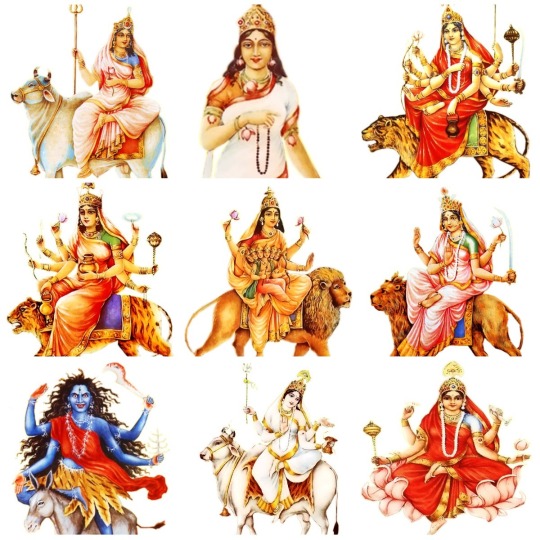
The seeds of inner renewal are sown, sprouting, watched & worshiped by devotees during Navratri and on the 8th, 9th and 10th days, Goddess Durga, Mahanavami and Vijayashtami are worshipped. The tenth day that is commonly referred to as Vijayadashami or "Dussehra", celebrates victory of Shakti over Mahishasura, of Lord Rama over Ravana, and of Durga over demons like Madhu-Kaitav, Chanda-Munda and Shumbha-Nishumbha; that is victory of good over evil.
The last 3 days of Navratri are called Durgashtami (8th day), Mahanavami (9th day) and Vijayadasami (10th day). On the morning of the tenth day there is a fire ceremony dedicated to Shiva, where the Navaratri participants have a chance to receive Shiva's blessing.
The beginning of spring and the beginning of autumn are considered to be important junctions of climatic and solar influences. That is why these two periods are taken as sacred opportunities for the worship of the Divine Mother Durga. The dates of the festival are determined according to the lunar calendar.
Navratri is a very important and major festival in the western states of India: Gujarat, Maharashtra, and Karnataka during which the traditional dance of Gujarat called "Garba" is widely performed. This festival is celebrated with great zeal in North India as well, including Bihar, West Bengal, Madhya Pradesh and the northern state of Punjab.
Durga, the Mother Goddess of the Hindus and a form of Devi and Shakti, is believed to have manifested in various forms, and Navadurga Maa are believed to be the most sacred aspects of Goddess Durga.
According to a Hindu tradition, it is believed that there are three major forms in which Goddess Durga manifested herself, namely, Mahasaraswati, Mahalakshmi and Mahakali who are the active energies (Shakti) of Brahma, Vishnu and Rudra respectively (without these goddesses the gods will lose all their powers).
These three forms of Durga further manifested in three more forms each, and thus emerged the nine forms of Durga, which are collectively called Navadurga or Nine Durgas:
1. Devi Maa Shailputri - The Navratri commences with the 1st night devoted to the puja of Maa "Shailputri". "Shail" means mountains; "Parvati", the daughter of king of Mountains Himavan, is known as "Shailputri". Her 2 hands, display a trident and a lotus. She is mounted upon a bull.

2. Devi Maa Brahmacharini - One hand holds a "Kumbha" or water port and the other rosary. She personifies love and loyalty. Maa Brahmacharini is a store-house of knowledge and wisdom. Rudraksha is her most adorned ornament.
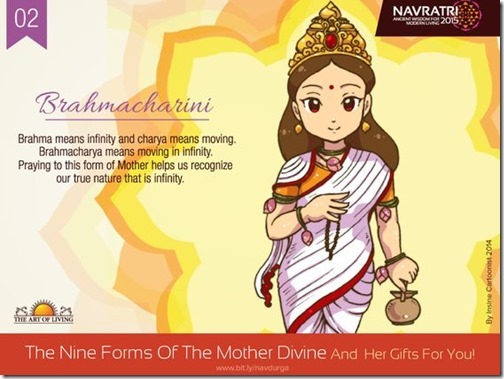
3. Devi Maa Chandraghanta - Worshipped on the 3rd night this Maa Durga "Shakti" is astride a tiger, displays a golden hue to Her skin, possesses ten hands and 3 eyes. Eight of Her hands display weapons while the remaining two are respectively in the mudras of gestures of boon giving and stopping harm. Chandra + Ghanta, meaning supreme bliss and knowledge, showering peace and serenity, like cool breeze in a moonlit night.

4. Devi Maa Kushmanda - The 4th night begins the worship of Maa "Kushmanda", possessed of eight arms, holding weapons and a mala or rosary. Her mount is a tiger and She emanates a solar like aura. "Kumbh Bhand" means to see cosmic vivacity in Pindi shape or knowledge of cosmic intricacies in human race. The abode of Maa "Kushmanda" is in Bhimaparvat.

5. Devi Maa Skandamata - Using a lion as a vehicle She holds her son, "Skand" in her lap while displaying 3 eyes and 4 hands; two hands hold lotuses while the other 2 hands respectively display defending and granting gestures. Its said, by the mercy of Maa "Skandmata", even the idiot becomes an ocean of knowledge such as "Kalidas".

6. Devi Maa Katyayani - As mother, Maa "Katyayani" stayed in the Ashram of sage Katyayan for penance, hence She named as "Katyayani". This 6th Shakti is also astride a lion with 3 eyes and 4 arms. One left hand holds a weapon and the other a lotus. The other 2 hands respectively display defending and granting gestures. Her complexion is golden coloured.
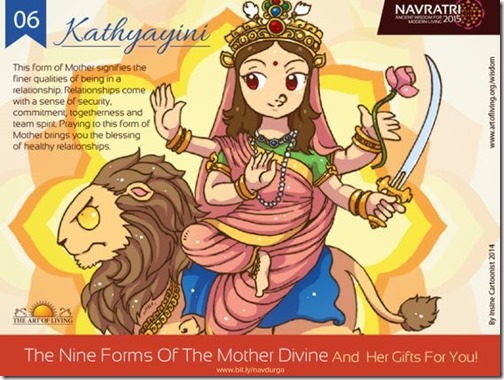
7. Devi Maa Kalaratri - Black skin with bountiful hair and 4 hands, 2 clutching a cleaver and a torch, while the remaining 2 are in the mudras of "giving" and "protecting". She is mounted upon a Donkey. The destroyer of darkness and ignorance, Maa "Kalaratri" is the seventh form of Nav-Durga meaning scourer of darkness; enemy of darkness. Maa Kalaratri's famous shrine is in Calcutta.
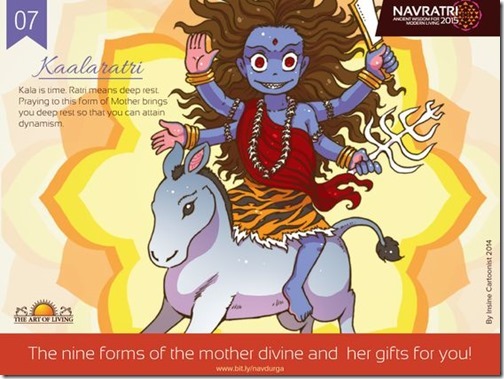
8. Devi Maa Mahagauri - Four arms with the fairest complexion of all the Durga Shaktis. Peace and compassion radiate from Her being and She is often dressed in a white or green sari. She holds a drum and a trident and is often depicted riding a bull. Maa "Mahagauri can be seen in a temple at Kankhal near pilgrim centre Haridwar.

9. Devi Maa Siddhidatri - Ensconced upon a lotus, most commonly, with 4 arms, and is the possessor of 26 different wishes to grant Her bhakts. Maa Siddhidatri's famous pilgrim centre, is located in Nanda Parvat in the Himalayas.

The nine manifestations of Maa Durga that are worshiped with fervor during Navratri, are believed to lift divine spirit in us to help us overcome obstacles and get liberated from unnecessary qualities to be filled with new freedom and purity.

All these nine names of Goddesses are decribed in "Devi Kavacha" of the Chandipatha scripture. Also called The Devi Mahatmyam or Devi Mahatmya ("Glory of the Goddess") it is a Hindu religious text describing the victory of the goddess Durga over the demon Mahishasura. As part of the Markandeya Purana, it is one of the Puranas or secondary Hindu scriptures, and was composed in Sanskrit around c. 400-500 CE, with authorship attributed to the sage (Rishi) Markandeya. Devi Mahatmyam is also known as the Durga Saptashati or Chandi Patha.
The other important work that focuses on veneration of the divine feminine is Devi Bhagavata Purana ("The Old Book of the Goddess"), also known as Shrimad Devi Bhagvatam or the Devi Bhagavatam.
#NAVRATRI#navaratri#9 goddes#Glory of the Goddess#durga#parvathi#parvati#lakshmi#hindu#hinduism#IHH Article
133 notes
·
View notes
Text
What is Navaratri? Benefits, Importance and Significance
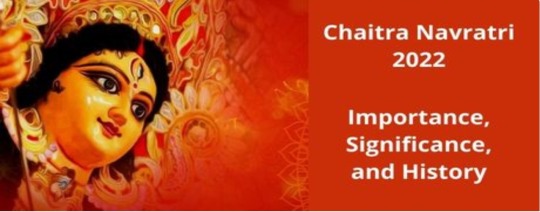
Since our childhood, a lot of us have been told, don’t eat chicken in Navratri. There have been a lot of other things we have been told that we should not do or should do. But there is one question we all might have had some time in our lives: Why is Navratri celebrated? What is Navratri?
Now a lot of you might have been curious at some point in your lives about several aspects of Navratri like: Is it a festival? Is it a series of festivals? Why is it celebrated 2 times a year? Is it about power? God? Gender? What is it that makes this entire nine days a celebration? SO, worry not… We at Rudraksha hub have heard you. In this blog, we will talk about Navratri, its importance, significance and benefits.
Let’s start with the first things first. Navratri, as the name suggests is nine days and nights celebration of Goddess Durga descending on Earth to remove all evils and bless all her devotees with utmost love, care, and blessings. Devi Durga is considered as the sign of victory over all odds and evils.
Navratri: A Celebration of Nine Days
Hence, these nine days are celebrated with love, hope, and devotion to get the blessings of Goddess Durga and always be safe in every avenue of life. The tenth day is celebrated as Dussehra, for the victory of good over evil.
There are 2 Navratris celebrated every year, Chaitra Navratri which comes in the Chaitra month of the Hindu calendar and Shardiya Navratri which comes in the Sharad month of the Hindu calendar. We just discussed Shardiya Navratri. In the next video, we will talk about Chaitra Navratri, the one which is upcoming and will be celebrated from 2nd April 2022 to 10th April 2022 and ends with Ramnavami on 11th April 2022. We will publish a blog on Ramnavami also very soon. We will link the video of this blog when we upload it alongside as well with all attached links. We have also published a blog of 51 Shaktipeeth and how the story of Adiyogi is connected to the story of Navratri and Shaktipeeth.
Best Rudraksha for Durga:
9 Mukhi Rudraksha is best for Nav Durga and Nav Grah. There will be a proper blog on the same as well. Stay Tuned...!!
Rudrakshahub provide 100% original 9 Mukhi Rudraksha along with Lab certificate of authenticity from government-recognized India’s top Gemological and Rudraksha Labs
Do not miss to check out the Navratri sale that will be live from 31st March and will end on 11th April 2022 after Ramnavami. More details will be mentioned as they arrive. Till then, Namah Parvati Pataye Har Har Mahadev...!!
#rudraksha#rudraksha mala#9 mukhi rudraksha#navarathri#original rudraksha#buy rudraksha online#best place to buy rudraksha
0 notes
Text
Shardiya Navratri 2021 -
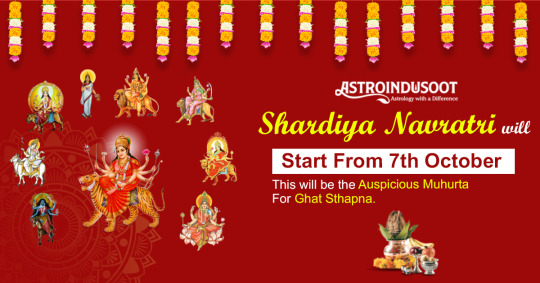
Shardiya Navratri 2021 —
According to the Hindu calendar, the Shardiya Navratri begins from the Pratipada date of the Shukla Paksha of the month of Ashwin, it is also called Ashwin Navratri. This time Shardiya Navratri is starting from the 7th of October, but this time due to one Navratri happening in Navratri, this time Navratri. According to the Hindu calendar, the Shardiya Navratri begins from the Pratipada date of the Shukla Paksha of the month of Ashwin, it is also called Ashwin Navratri. This time Shardiya Navratri is starting from 7th October, but this time due to one Navratri happening, there are only eight days instead of nine days. In this article, you will be able to get all the information that you need this Navratri…!!
In Navratri, Goddess “Shailputri” is worshiped on the first day of the nine forms of the goddess, “Brahmacharini” form on the second day, “Chandraghanta” on the third day, “Kushmanda” on the fourth day, “Skandmata” on the fifth day, “Katyayani” on the sixth day, “Kalratri” on the seventh day, “Mahagauri” is worshiped on the eighth day and “Siddhidatri” on the ninth day of Navratri. Worshiping of girls ‘Kanya Puja’ in Navratri is a very important part of this, in which the blessings of small girls are obtained by offering them various delicacies by considering them in the form of Mother Goddess. The date for people worshiping Kanya on the day of Ashtami is October 13th, and the date for those who worship Kanya in Navami is 14th October.
What is there special about this Navratri:
This time Shardiya Navratri is starting from Thursday 7th October and it will be from 7th till 14th of October, this time Navratri is decreasing due to “Chaturthi Tithi” so the festival of Navratri will remain for eight days. If we look at the sequence of Navratri, then on 7th October, Pratipada i.e. the first Navratra will start, on this day Ghatasthapana will be done. After this second Navratri on the 8th, Tritiya and Chaturthi will be together on the 9th, and Panchami on the 10th.
This time Mata’s ride
According to classical belief, MATA’S ride is done on Thursday and Friday, Therefore this time MATA will come riding in a doli and she will return only by the ride of the doli. It is believed that the arrival of the mother in the doli ride in Navratri strengthens female power, but it is also considered a sign of natural and political upheaval, so in the next few days the dominance of women will increase at the national and international level. The situation of chaos will also come to the fore.
The dates of Navratri -
1- Pratipada October 7: Maa Shailputri
2- October 8: Maa Brahmacharini
3-Tritiya / Chaturthi October 9: Maa Chandraghanta / Maa Kushmanda
4-Panchami October 10: Maa Skandmata
5-Shashti October 11: Maa Katyayani
6-Saptami 12 October: Maa Kalratri
7-Ashtami 13 October: Maa Mahagauri (Durga Ashtami)
8-Navami October 14: Maa Siddhidatri (Maha Navami)
Start Navratri like this -
For the worship of Mother Goddess in Navratri, where some people establish the idol of Mother Goddess in their house for nine days, most of the people also establish Kalash or Ghat… So for this, on the first day of Navratri i.e. Pratipada. Lay a red cloth on a wooden post near the place of worship of the house or in the northeast of your house. Place the idol of Mother Goddess on it and if you want to establish the Kalash, then you should also place it near the puja Ghar of your house or in the northeast of your house and regularly during the nine days of Navratri by incense, lamp, sweets, fruits, and flowers Worship the holy MATA.
The auspicious time for Ghat sthapna or establishment -
This time there are two special Muhurta for Ghat establishment, first Muhurta is between 6:17 to 7:44 in the morning of 7th, at this time auspicious Choghadiya Muhurta will start. After this, the auspicious time will start from 9:30 am on 7th, which will remain till 11:43 am.
First Muhurta of Ghat Establishment — 6:17 am to 7:44 am
Second Muhurta of Ghat Establishment — 9:30 am to 11:43 am
Must do these five things in Navratri -
-Daily worship: Every morning and evening in Navratri, it is necessary to do aarti of MATA by lighting a lamp and lighting incense in front of the idol of the Mother Goddess, and if you complete it regularly, then the special grace of the Mother Goddess is received.
-Donation: Navratri period is the best for worshiping Goddess Durga, but the donations made during this time have great glory, therefore, according to one’s ability during Navratri, do religious works and provide food, food items, clothes, etc. to needy people.
-Service: During the Navratri period, if you go to any temple and do any kind of service (cleanliness/maintenance/arrangement of offerings etc.), then you get the special grace of Mother Goddess.
-Restraint: On the nine days of Navratri, you should have complete restraint (control) on your mind, speech and thoughts, if you worship Mother Goddess with complete restraint on the nine days of Navratri then Maa Durga is pleased and bestows her special grace on you.
Do not do these 5 mistakes in Navratri-
-Tamasic diet: Tamasic diet (onion, garlic, alcohol, etc.) should be banned during Navratri by using them, MATA won’t be pleased and there will be degeneration in the house.
-Grihaklesh: At the time of Navratri, Mother Durga resides in your house, so there should not be any kind of discord or mutual quarrels in the house during the Navratri period, due to which the happiness of Mother Goddess is disturbed and the progress of your house stops.
-Denial of celibacy: Follow celibacy during the Navratri period, during this time husband and wife should renounce indulgences, and celibacy should not be denied.
-Misconduct: Do not impure your behavior during Navratri, keep your thoughts pure and behave well with everyone, do not pollute your speech, do not use any kind of abusive words.
-Do not leave home: During the Navratri period, Mother Durga comes to your house in the form of energy and if you are not in such a situation, then you will not be able to get the blessings of the mother and it also hinders the progress of the house, so Do not leave the house alone during Navratri period.
Conclusion
This time Shardiya Navratri will be from 7th October 2021 to 14th October 2021, Tritiya and Chaturthi date will be on the same day on 9th, hence Navratri will remain for eight days, on 7th October the first Navratra will be at 6:17 am to 7:44 am. In the middle and after that between 9:30 to 11:43, there will be an auspicious time to establish Ghat. Durga Ashtami will be on 13th October and Mahanavami will be on 14th October, so Kanya-Poojan of Ashtami will be done on 13th and Navami’s Kanya Poojan will be done on 14th.
0 notes
Photo
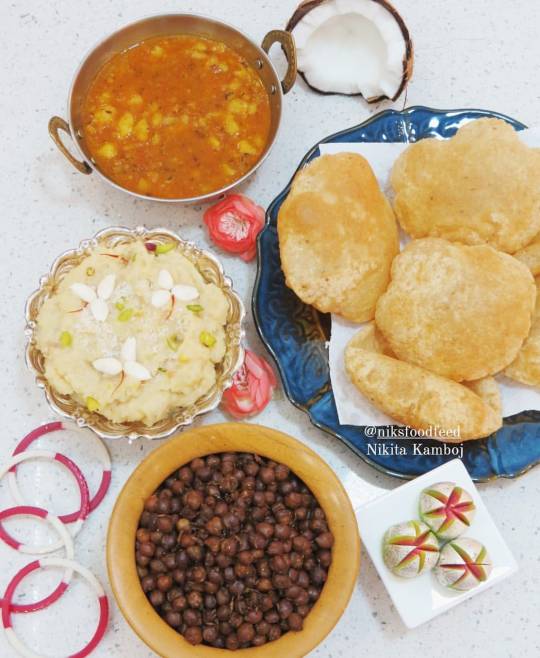
Happy Ram Navami 🙏🏻 Navratri day 9 - the last day of Navratri, and hence it is celebrated with much fervour. Navami food- (kanya bhoj) sooji ka halwa (semolina porridge) Kale chane (black gram) poori Aloo tamatar sabji Kaju flower sweets . . . . . . . . . #indianfood #Ramnavami #navratri #kanjak #kanjakfood #navratrifood #vegan #veganfoodporn #poori #festive #healthyfood #healthyeating #healthy #superhealthy #healthyliving #halwa #desserts #food #foodporn #foodgasm #foodgram #foodie #foodies #foodphotography #foodpics #fitfoodie #yummy #healthylifestyle #instafood #picoftheday (at Delhi, India) https://www.instagram.com/p/CN6gZnagMUG/?igshid=1ghxjg42zsz41
#indianfood#ramnavami#navratri#kanjak#kanjakfood#navratrifood#vegan#veganfoodporn#poori#festive#healthyfood#healthyeating#healthy#superhealthy#healthyliving#halwa#desserts#food#foodporn#foodgasm#foodgram#foodie#foodies#foodphotography#foodpics#fitfoodie#yummy#healthylifestyle#instafood#picoftheday
0 notes
Text
Style The Nine Days Of Navratri
The holy festival of Navratri is about to begin. Hindu devotees are gearing up themselves to celebrate these auspicious nine days in full fervor. The festivity is celebrated in the honor of Goddess Durga’s nine avatars, where each day has its significance. Puranic literature marks these auspicious days as a victory over evil and dedicates unique auspicious colors to each deity. Most people adhere to this color code to show their respect. If you wish to make your festive days memorable, refer to the color and shopping guide by PCL for Navratri 2021.
DAY 1
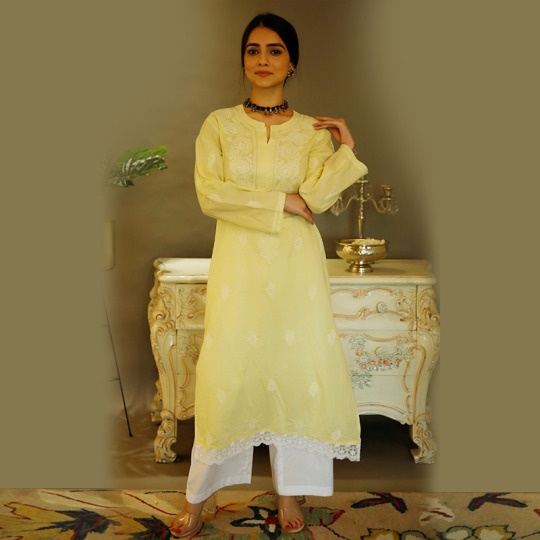
The first deity celebrated in this festivity is Goddess Shailputri. She represents happiness, alacrity and therefore, the perfect color for the day is orange. For you, we have bought a perfect rust orange color Chikankari Kurta that you can style with white palazzo pants. People usually feel that Chikankari falls on the yesteryear corner, but the myth is actually broken with this Kurta.
It has subtle hand embroidery over the neck with little leaf motifs all over the sleeves and Kurta. The second highlight of this Kurta is its net detailing with scalloped flowery ends, beautiful for elevating the ordinary to extraordinary!
DAY 2

The second day of Navratri celebrates purity and is dedicated to Goddess Brahmachari. No color can represent purity better than white. The name Brahmachari is a meaningful derivation from two words, “Brahma,” which means tapa or penance, and “Charni,” meaning an ardent female follower. The goddess is believed to have immolated herself in the sacrificial fire of yagna; hence the hue for the day is white.
To ensure that you are able to show your honor for the goddess, we have bought a perfect white cotton Kurta set for you. The set features a short white Kurta with red and white floral detailing, a round neck, and hemmed sleeves with elastic detailing. The subtle detailing and beautiful color will provide you the autonomy to style them up with any bottoms (however, the set includes white flared palazzo).
DAY 3
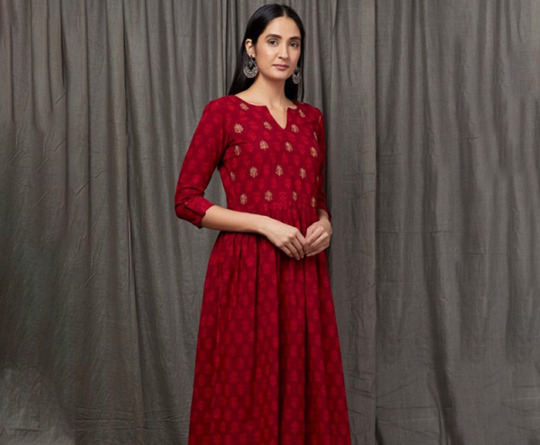
As per the puranic literature, one should wear the color grey on the third auspicious day of Navratri. The day is staunched to Devi Chandraghanta, meaning “one ,who carries a half-moon on her forehead.” It is believed that the deity has her third eye always open to war against demons. This deity’s true bhaktas are rewarded with her grace, courage, and bravery. Her grace has the power of eradicating all the sins, physical sufferings, mental distresses, and ghostly hurdles. Therefore, it is suggested that one must wear the color red on this auspicious day.
The whole festivity is ideal for showcasing the traditional wardrobe you own. If you have any red outfit in your closet, wear the same with matching accessories. Otherwise, buy a beautiful subtle designer Kurti from PCL.
DAY 4
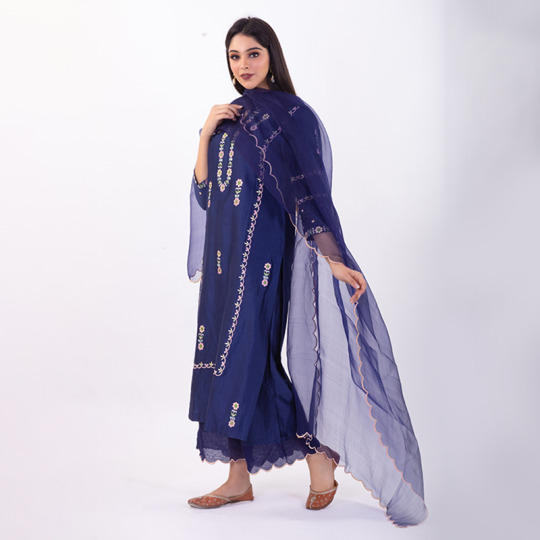
The fourth day of Navratri is to worship Goddess Kushmanda. The deity is considered to bless its devotee with health and wealth, and the auspicious color-marked for this day is royal blue. If you wish to style a royal blue color outfit but don’t have one in your closet, lay your hands on this gorgeous Chanderi silk suit. The skilled craftsmanship and glorious hand-embroidery detailing will allow you to look festive ready effortlessly.
DAY 5
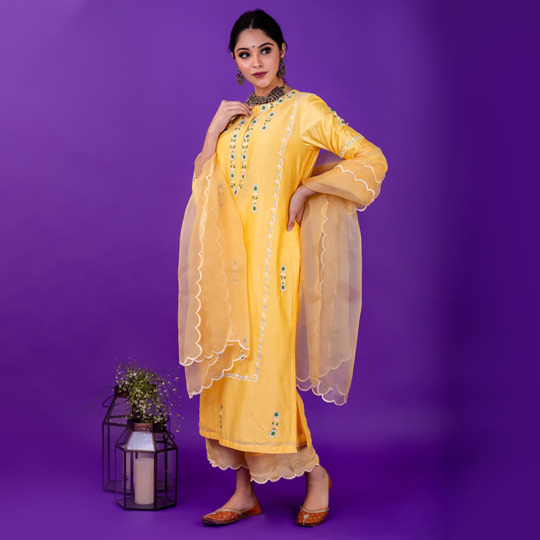
The fifth day of the Navratri is dedicated to the goddess Skandamata. She is considered to be the deity of happiness, and the special color for the day is yellow. PCL, therefore, suggests that to bring joy and happiness to your life, you must wear clothes of this hue. If you don’t stock any Kurti set in the color, check out our website and buy the best yellow hand embroidered tiered bandhani cotton Kurta with a pair of white cotton pants.
The best thing about bandhani Kurtas is that these clothes provide you the perfect festivity touch. If you wish to go for a dandiya party, pair a bandhani skirt with this outfit, and effortlessly you will be “designer navratri” ready.
DAY 6

On the sixth day of the Navratri, the Hindu devotees worship Devi Katyayani. The deity signifies new beginnings and growth. Hence, honor the deity and wear a green Chanderi silk Kurta set by PCL. The Kurta is designed to perfection using hand embroidery. It has little flower motifs over the chest area, and the rest of the Kurta is beautifully plain. The set features basic Chanderi pants, and the highlight of the outfit is the scalloped dupatta.
DAY 7
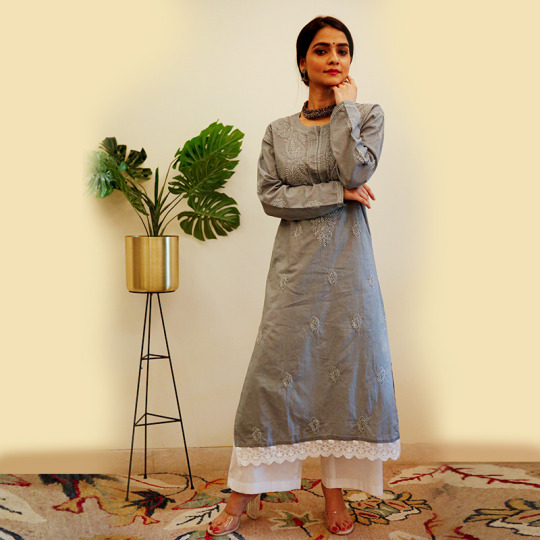
The seventh day of Navratri is marked to celebrate Goddess Kalaratri. According to the puranic literature, the perfect color for the day is grey. It symbolizes strength to transform. We at PCL can’t think of a better combination than a grey Chikankari on the blistering summer day. Check the Kurti set (with grey Kurta and white cotton pants) for styling yourself on the seventh day of Navratri.
DAY 8
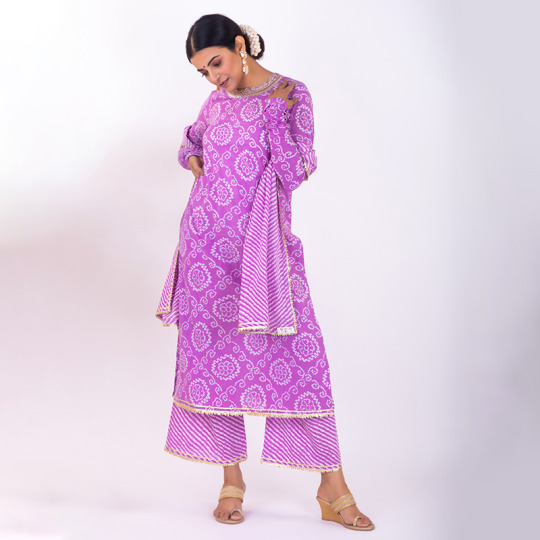
The eighth day of Navratri is celebrated to worship Mahagauri, where most Hindu devotees perform a special Kanjak Pooja. The day symbolizes the power of intellect and peace, and therefore, there can be no better color than purple to depict it. As it is the second last day of festivities, we suggest that you go for something that has heavy detailings.
You don’t have to comb markets. Instead, we have bought you a perfect purple hand embroidered bandhani peplum top. We perceive the top as a western outfit, so this is more of a Kurta top. It features waist-up length with semi-sleeves and embroidered V-neck. The outfit comes with a pair of bandhani strap pants with a bit of gota detailing at the hem.
DAY 9

The last day of the celebration is marked as Navami. It is packed with rituals to commemorate the entire week-long festivity. Goddess Siddhidhatri is worshiped on this day, and it is suggested that one must wear peacock green color to fulfill all their desires.
On the last day, you must present your A-game and to help you celebrate the last day festivities with a peacock green color outfit, we have selected PCL’s Chanderi silk Kurta suit. The set features a green Kurta with subtle gold embroidery, a matching green palazzo pant, and a scalloped organza dupatta. You can accessorize this outfit with a gold choker set, matching earrings, and Jutti footwear.
Source: Style The Nine Days Of Navratri
#Chanderi silk Kurta suit#embroidered bandhani peplum top#women bandhani Kurtas#buy designer kurti online in navratri
0 notes